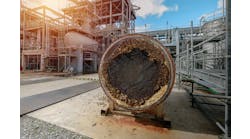Have you checked your cooling tower basin lately for accumulation of dirt? Are your vertical turbine pumps constantly wearing out? Are your heat exchangers plugging up frequently?
Cooling towers can process thousands of cfm of air from the surrounding area. Depending on local site conditions, that air can be heavily laden with dust. The air passes through what could be described as an air wash system; large amounts of dust become trapped in the cooling tower. That dust then becomes a system contaminant that can lead to poor tower, heat exchanger and pump performance.
Jake Investigates
Jake got a call from a local plant asking if he could help evaluate a poorly performing cooling tower that didn’t seem to be putting out design temperatures. Jake visited the site to investigate the complaints. He and the site engineer did a walk around the tower. Jake noted the water in the tower seemed very cloudy, indicating high suspended solids. The site engineer shared that the plant had been doing a lot of heat exchanger cleaning. Jake also noted strange patterns in the flow falling through the splash fill — some areas were dry and others were waterfalls. This could mean some sort of distribution problem within the tower.
Jake and the site engineer climbed to the fan deck and inspected the distribution basins. Some of the nozzles that meter flow to the tower were missing but whole sections of the basins were dry, meaning perhaps the load was light or that too many cells were in operation. Before going back to the office, they asked operations to redistribute the water flow to a few cells, enough to bring the basin level up to design.
The tower was an 11-cell, crossflow unit. Plant managers had considered increasing the tower by 1–2 cells due to the lack of cooling capacity. The tower originally had been a simple splash fill design but in the past decade the inner section had been converted to film fill. In addition to the cooling function, the tower basin also served as a backup water resource for the plant’s fire extinguishing system.
Jake and the plant engineer reviewed their observations: flow was maldistributed, there seemed to be blockage in the fill, the solids in the water were out of control, and a lot of sediment existed in the lower basin.
After the tower flow had been redistributed, Jake and the plant engineer climbed to the top again and began a cross check of the flow. Following that, they conducted a mini performance test. The results showed that performance had improved although it was still below design.
The plant scheduled a maintenance shutdown of the tower to coincide with the next plant outage. Jake returned to assist with the inspection.
He inspected one cell first. As the maintenance crews worked towards the fill, it was obvious the film fill was holding dirt; the film collapsed during attempts at removal. The dirt had built up to the point that the film packs weighed 10–15 times their original weight. They were nearly completely blocked. Sediment filled almost the entire lower basin. The basin provided significantly reduced residence time and the sediment would periodically slump off and damage the pumps and settle in the plant’s heat exchangers.
Maintenance cleaned the basin and installed a side stream filter. A new clog-free film fill replaced the damaged fill. The pumps were rebuilt. Nozzles in the upper distribution basins were replaced with a smaller diameter to keep the basins from running dry.
Plant operators placed the tower back in service. A full performance test revealed the tower was at design specifications. Over the next several months, maintenance cleaned the system and documented significant improvement in heat exchanger performance. The pumps also were monitored; their performance remained steady following the rebuilds.
So, before summer temperatures start, check your tower performance. Do a walk around inspection and look for damaged fill, unusual flow patterns and excessive sediment buildup in the lower basin. In the upper basins, check for proper balance both between cells and across the tower. Also look for missing nozzles and assess the performance of the pump and heat exchanger.
Happy energy hunting.
Active in both, the American Society of Mechanical Engineers and the American Society of Heating, Ventilating, Refrigerating, and Air-Conditioning Engineers (ASHRAE), Clark was chairman of ASHRAE's task group on Halocarbon Emissions and served on the committee that created ASHRAE SPG3 - Guideline for Reducing Halocarbon Emissions. He has written numerous papers on CFC alternatives and retrofitting CFC chillers. He was awarded a U.S. patent on a method for reducing emissions from refrigeration equipment. He has served as technical resource for several others.
You can email him at [email protected]


